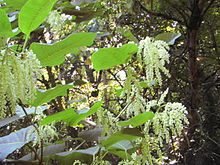| Reynoutria sachalinensis | |
|---|---|

| |
| Scientific classification | |
| Kingdom: | Plantae |
| Clade: | Tracheophytes |
| Clade: | Angiosperms |
| Clade: | Eudicots |
| Order: | Caryophyllales |
| Family: | Polygonaceae |
| Genus: | Reynoutria |
| Species: | R. sachalinensis
|
| Binomial name | |
| Reynoutria sachalinensis (F.Schmidt) Nakai
| |
| Synonyms[1] | |
| |
Reynoutria sachalinensis (giant knotweed or Sakhalin knotweed (syns. Polygonum sachalinense, Fallopia sachalinensis) is a species of Fallopia native to northeastern Asia in northern Japan (Hokkaidō, Honshū) and the far east of Russia (Sakhalin and the southern Kurile Islands).[2]

Reynoutria sachalinensis is a herbaceous perennial plant growing to 2–4 m (79–157 in) tall, with strong, extensively spreading rhizomes forming large clonal colonies. The leaves are some of the largest in the family, up to 15–40 cm (6–15.5 in) long and 10–28 cm (4–11 in) broad, nearly heart-shaped, with a somewhat wavy, crenate margin. The flowers are small, produced on short, dense panicles up to 10 cm (4 in) long in late summer or early autumn; it is gynodioecious, with male and female (male sterile) flowers on separate plants. The species is closely related to the Japanese knotweed, Reynoutria japonica, and can be distinguished from it by its larger size, and in its leaves having a heart-shaped (not straight) base and a crenate margin. Reynoutria sachalinensis has a chromosome count of 2n=44.[3][4]
- ^ The Plant List, Reynoutria sachalinensis (F.Schmidt) Nakai
- ^ "Reynoutria sachalinensis". Germplasm Resources Information Network. Agricultural Research Service, United States Department of Agriculture. Retrieved 1 January 2018.
- ^ Flora of NW Europe: Fallopia sachalinensis[permanent dead link]
- ^ Huxley, A., ed. (1992). New RHS Dictionary of Gardening. Macmillan ISBN 0-333-47494-5.[page needed]